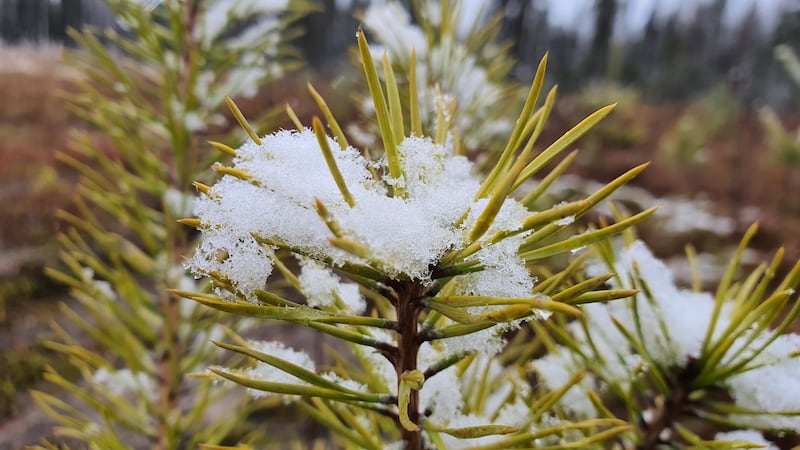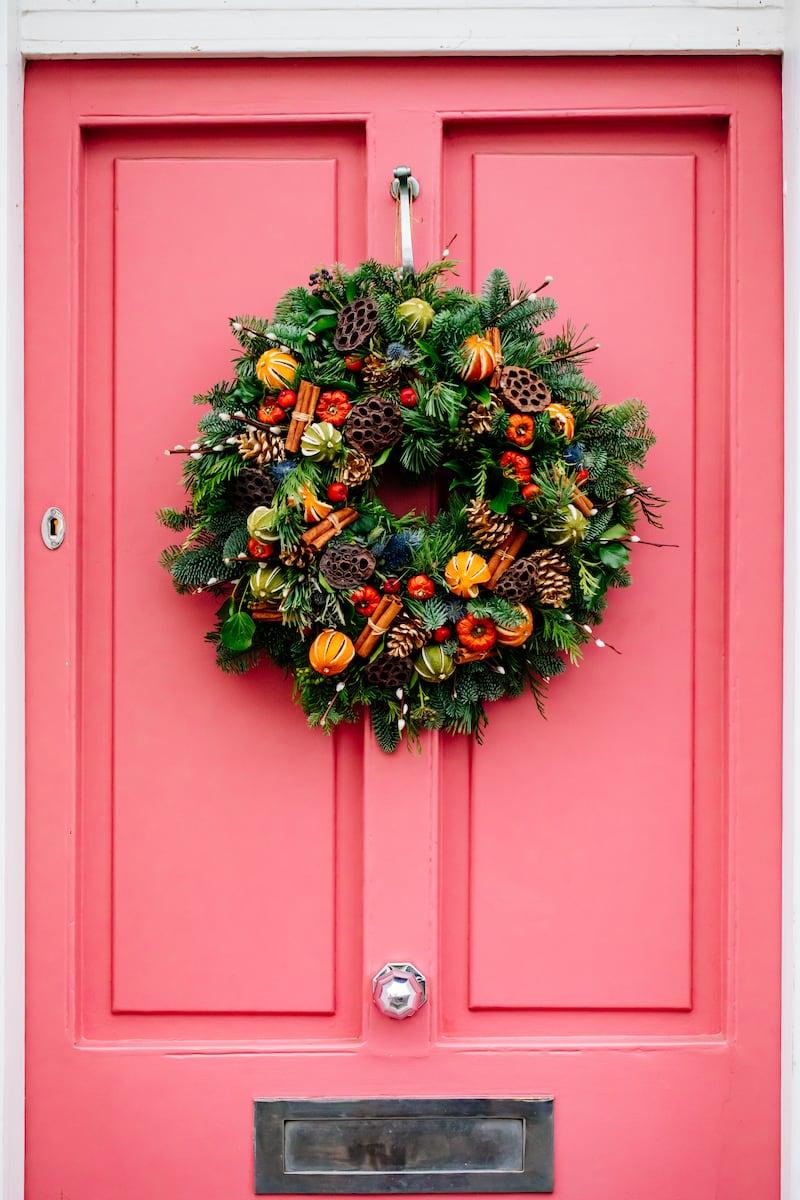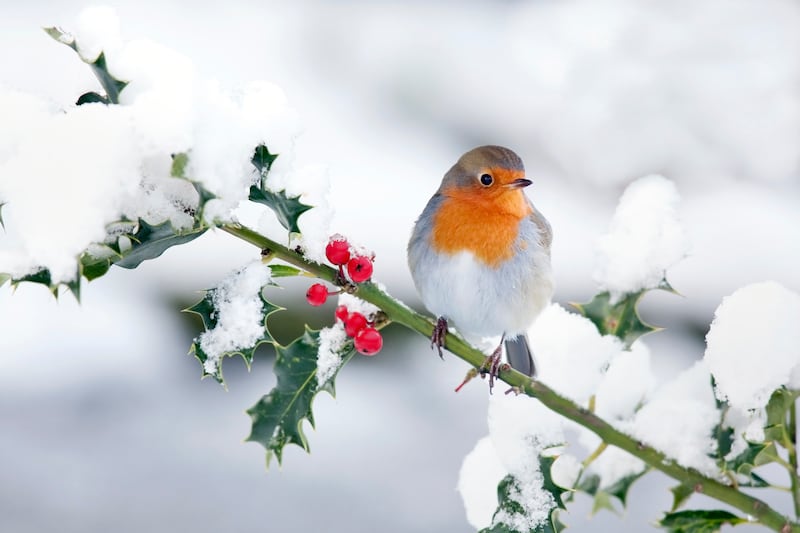Sometimes it takes the kind of bone-chilling wintry weather of recent weeks to reignite our appreciation of the resilient evergreens that grow in our gardens, hedgerows and wild places. The kinds of plants that endure fierce frosts and snow unscathed, and which are so symbolic of the enduring themes of a traditional Irish Christmas and bleak midwinter, of the circle of life, rebirth and renewal. Like native ivy, for example, its woody branches spangled with the plant’s sculptural, moss-green, man-of-war seed heads. The rugged, grey-green needles of Scots pine (Pinus sylvestris). Yew (Taxus baccata), the uses of which go back to druidic times, and spiky holly (Ilex) with its spiny, shiny leaves and scarlet berries.
Speaking of seasonal berries and fruits, there’s nothing prettier than the native spindle (Euonymus europaeus), which has bare branches laden down with jewel-like clusters of deep-pink and orange fruits at this time of year. Or the wild dog-rose (Rosa canina), which is a bright scarlet colour, nutritious hips – ‘or itchybacks, cow-itches, or ticklers’ as the Irish wild flower expert and botanical historian Zoe Devlin so vividly records them – lace the winter hedgerows. For Christmassy cones, there’s deciduous larch (Larix decidua) as well as alder (Alnus glutinosa), with bare winter branches that are simultaneously festooned with soot-purple catkins and cone-like fruits. All are plants that happily tolerate the kind of fierce, minus-zero temperatures of recent weeks that have us humans snuggling indoors.

They’re also wonderful ingredients to use in Christmas arrangements that sing of the rugged beauty of the Irish landscape and the special charm of seasonality. Pop some branches of berried mountain ash (Sorbus), a few fluffy seed heads of old man’s beard or wild clematis (Clematis vitalba) and some wild rose hips into some small glass posy vases and you’ll be astounded by how instantly beautiful it looks. Even just a few lengths of wild ivy and cone-covered larch artfully placed to run along its centre will turn the most pared-back of Christmas tables into something that feels properly seasonal.
Adding some wild or garden-foraged stems to conventional shop-bought flowers will also do a lot to pump up the wow factor. Mix some stems of wild ivy, heather, bare birch branches and alder through a bunch of shop-bought flowers, for example, and you’ll be astonished by how quickly and how much they transform the most ordinary arrangement. Even something as simple as tucking a few sprigs of pine under the ribbons of wrapped presents will make them feel extra festive. And some of that proper old-style Christmas magic is exactly what our world needs right now.
READ MORE
How to make a traditional Christmas wreath
Avoid using a floral foam base for environmental reasons. Instead make your own base using a 12-inch or 14-inch wire circular base (this can be reused again for several years), a reel of strong wire (ideally the type known as binding wire), spaghnum moss and a generous selection of foliage and berries. Start by securing the end of the binding wire to the circular wire base and then use it to clothe the base in moss. Repeatedly wrap it firmly in and around the base as you place the handfuls of moss in position so that you eventually end up with a perfectly mossed-up circle.
Always try to tie the wire firmly but not so firmly that it creates a moss ring that’s very stiff and rigid; you want just enough wriggle room to be able to push some branches through it in the final stages of construction. Once you’ve finished mossing the base up, then fasten the end of the wire firmly in place to make sure it doesn’t unravel (a couple of firm twists should do the trick).
[ The A-Z of Christmas gardening giftsOpens in new window ]
Next, take three shortish lengths of foliage (use a mixture of species each time for a nice, natural effect), arranging them on a section of the base so that one piece sits to the outer edge, one sits in the middle and one sits to the inner edge, with all of them pointing in roughly the same anticlockwise direction. Try to position them in a way that gives you a nicely bushy, plump effect with none of the moss base visible. Using the binding wire in the same way as before, wrap it firmly around these three stems a couple of times. Then repeat this step, placing the next layer of three stems on to the base immediately beneath the first layer, with the bases of their stems concealed beneath the upper ends of the previous three pieces of foliage.
Continue to work your way around the entire base in this anticlockwise direction, making sure to firmly wrap each new layer of foliage with binding wire as you go, always keeping the wire taut to prevent any branches from coming loose. Once you’ve come full circle, you should end up with a lovely plump wreath of foliage. Then firmly secure the end of the wire into the wire base, making a little hanging circle to the back of the base as you do so (this makes it easier to hang the wreath from a nail or screw).

You can either use your wreath just as it is (it will already look beautiful) or embellish it further by pressing individual stems and branches into the mossy base. Dried orange slices, cinnamon sticks, ornamental berries and pine cones are other traditional elements that are often added to give it a real Christmassy feel. Discreetly secure these in place with short lengths of wire pressed deep into the mossy base. Then finish it all off with a nice length of velvet ribbon for maximum effect.

Remember that this sort of circular wreath can also be used as a seasonal table centrepiece. Just lay it flat rather than hang it and then place a nice tall Christmas candle in the middle for some added festive feel.
This week in the garden
The severe cold weather of recent weeks has really highlighted the need to provide garden birds with a ready source of food and fresh water. So, try to regularly scrub down and clean bird feeders before refilling them to reduce the risk of disease, and place a shallow container of clean water somewhere out of reach of cats so that birds can safely drink from them. Likewise, you can prevent garden ponds from completely freezing over by placing a ball to float in the water.

That same unusually cold weather has almost certainly caused damage to more vulnerable garden plants, the scale of which will only become fully apparent in the months ahead as they start back into growth. But be patient and don’t start cutting damaged plants back just yet or assume that they’ve been killed simply because their leaves have been blackened, look curled or wilted. Most will recover with time. To protect them from damage from further unusually cold weather, cover vulnerable plants with a layer or two of horticultural fleece when required and cluster container-grown plants tightly together under the overhang of a roof.
[ Why it’s important for gardeners to protect their gardens from windy weatherOpens in new window ]














